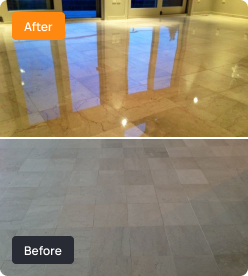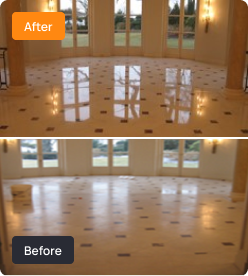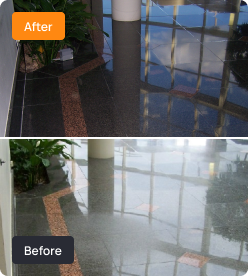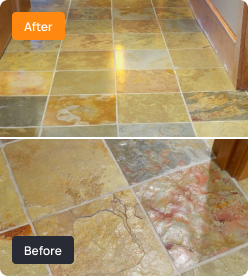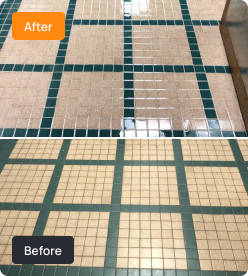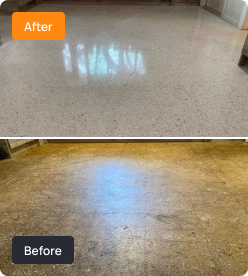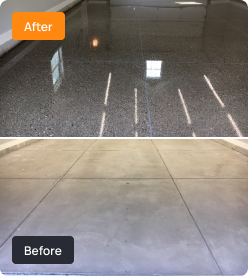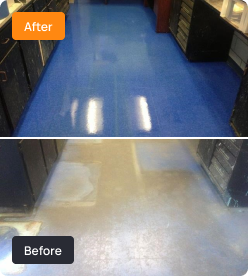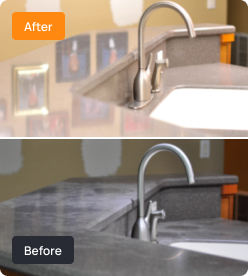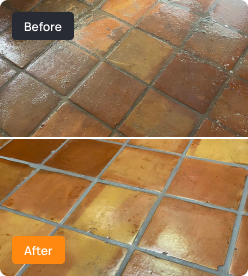Got Marble or Limestone Here’s Why Vinegar’s Not Your Friend
Marble countertops gleam in the kitchen’s ambient light, and limestone flooring spreads out, cool underfoot, in the hallway of many homes. These natural stones, chosen for their look, elegance, and appeal, can uplift the ambiance of any room. However, it may come as a surprise that a common household item, often used as a natural […]
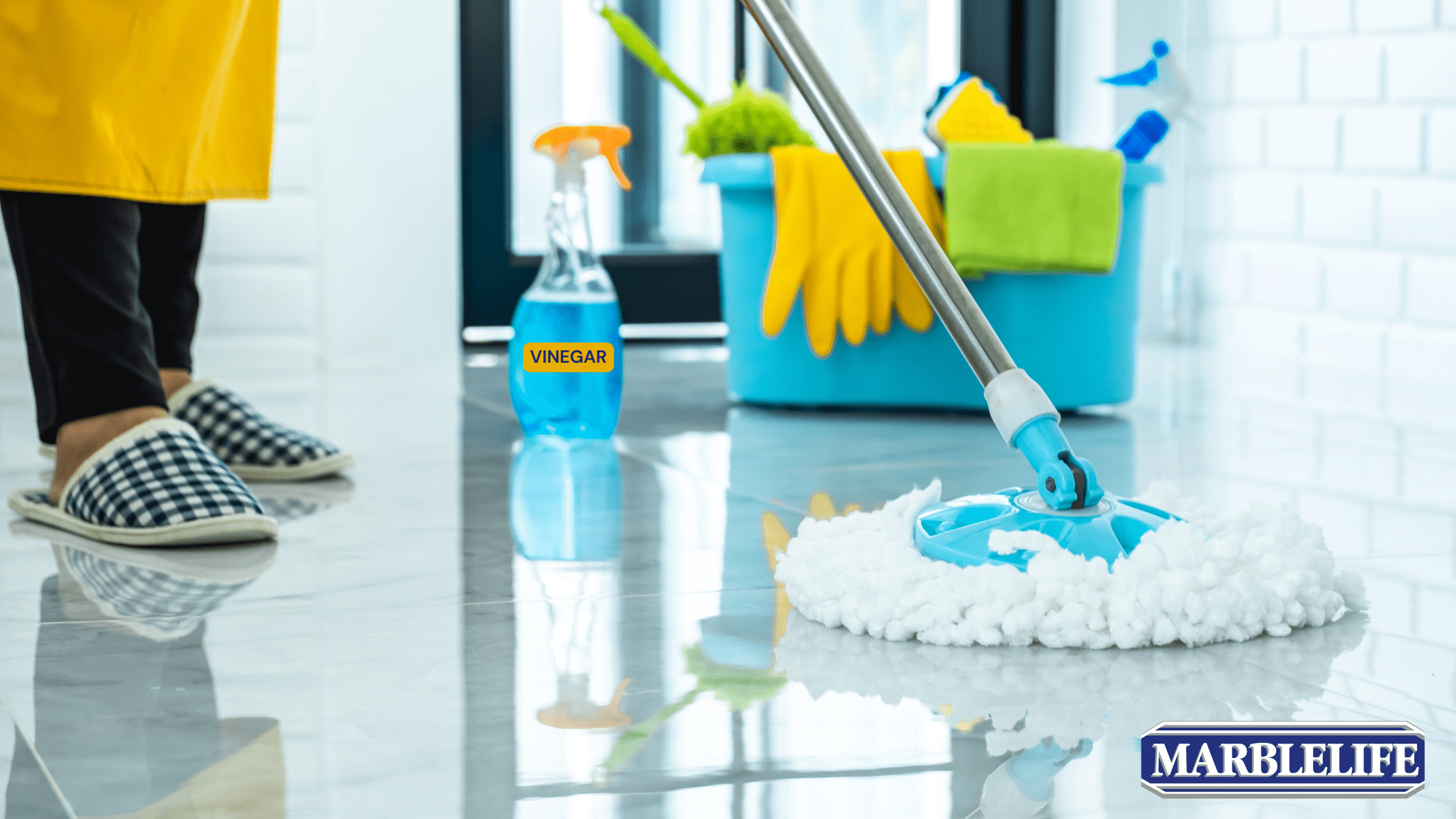

Marble countertops gleam in the kitchen’s ambient light, and limestone flooring spreads out, cool underfoot, in the hallway of many homes. These natural stones, chosen for their look, elegance, and appeal, can uplift the ambiance of any room. However, it may come as a surprise that a common household item, often used as a natural cleaning hack, can be detrimental to these surfaces. In fact, just one mistaken application of this everyday product can cause thousands of dollars in damage!
The Composition of Marble and Limestone
Marble and limestone consist of calcium carbonate, derived from the remnants of ancient marine life, such as shells and coral. The transformation of these remains into the stone we use today requires millions of years, along with specific conditions of heat and pressure. Marble is created when limestone undergoes further intense pressure, a metamorphic process that recrystallizes the original material to form marble. This is significant because, due to their calcium carbonate content, both marble and limestone are sensitive to acids, which can dissolve calcium carbonate. Consequently, substances like vinegar can cause damage to marble and limestone, visible as dulling or etching.
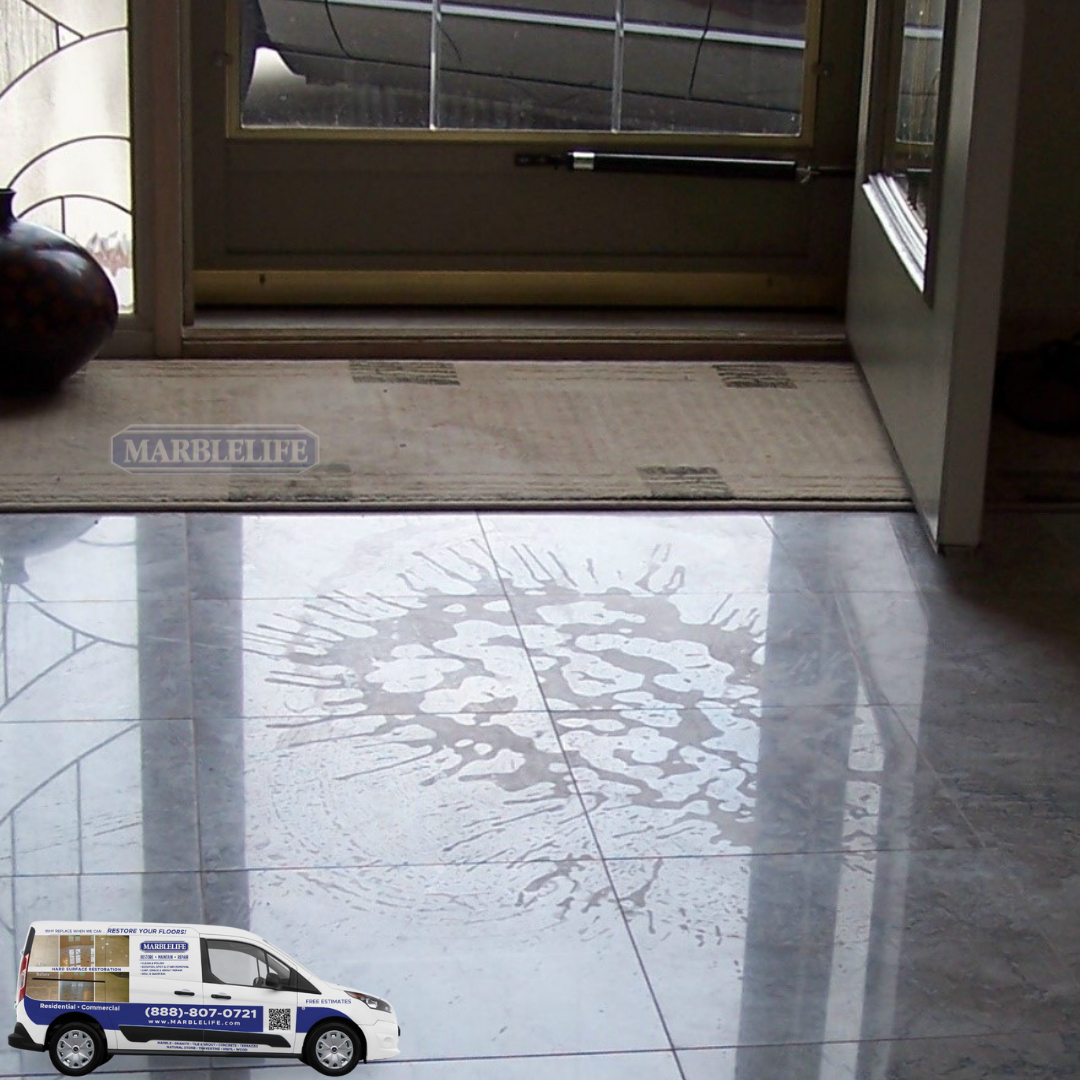
Surface Damage from Spilled Salad Dressed with Vinegar on Marble Floor
This picture shows a scenario where things go wrong while taking out the garbage: a garbage bag tears apart, and a dinner salad dressed with vinegar spills onto the marble floor. The spill marks etched into the floor are impossible to clean, revealing where the stone has been dissolved. Unfortunately, attempting to mop the spill rather than blotting it up worsens the situation, reacting with and damaging the stone. The best that can be achieved now is a clean etch mark, free of dirt and oil, as no cleaner can restore the lost marble. The floor will require restoration through diamond honing and polishing to be genuinely “cleanable” again.
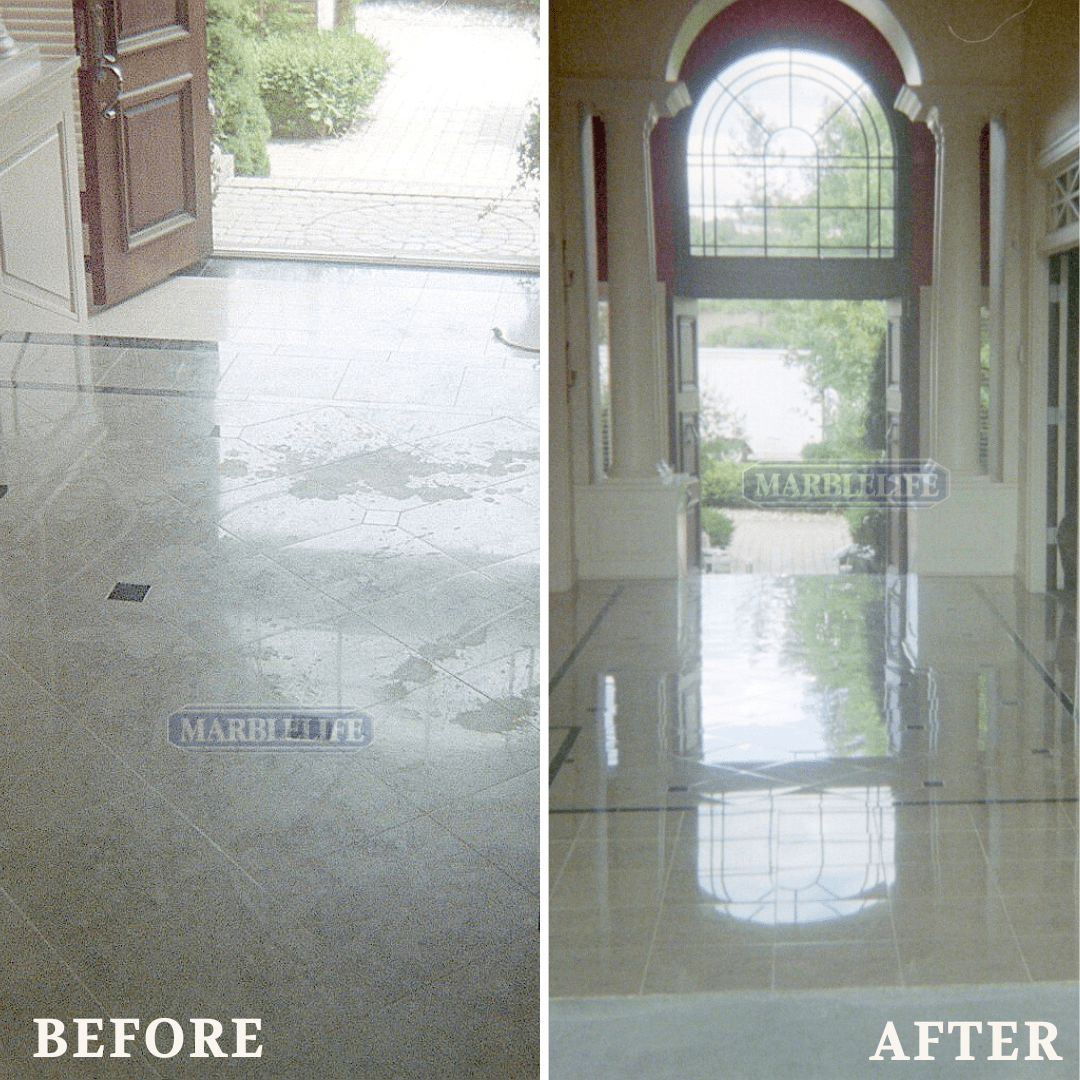
Surface Restoration with Diamond Honing and Polishing
This damage resulted from a single accidental spill. However, the effect is more subtle when cleaning the entire surface intentionally. The consistent dulling reduces the contrast, making the damage less noticeable until the floor loses its glossiness.
The Importance of Using the Right Cleaning Agents
While both marble and limestone are sturdy and durable, their chemical makeup makes them susceptible to damage from certain substances, especially acids. Using inappropriate cleaning agents or exposing them to acidic foods and drinks can lead to stains, etching, or even structural damage. To ensure the longevity and pristine appearance of stone surfaces, it is crucial to use cleaning agents specifically formulated for these types of stone.
The Downside of Vinegar as a Cleaner
Vinegar, derived from the French term “vinaigre,” meaning “sour wine,” has cemented its place in the hall of fame for DIY cleaning solutions. Its natural origin stems from the fermentation of ethanol by acetic acid bacteria. This simple, age-old liquid boasts a versatility that stretches beyond culinary use to a reliable cleaning agent. Its eco-friendly attributes, non-toxic nature, and affordability have only bolstered its appeal among environmentally-conscious homeowners.
From its success in cutting through stubborn grease to leaving windows streak-free, its applications seem almost endless. Such widespread endorsement has led many to believe vinegar is the quintessential green cleaner, leading the charge against dirt and grime in the eco-friendly brigade.
But is it really safe for all surfaces?
Why Vinegar Damages Natural Stones
At its core, vinegar is primarily composed of acetic acid. This organic compound is responsible for vinegar’s tangy taste and pungent smell. But more than its culinary attributes, acetic acid’s nature gives vinegar its cleaning prowess.
The pH scale, ranging from 0 to 14, specifies the acidity or basicity of an aqueous solution. Anything below 7 is acidic, while a reading above 7 indicates basicity. Pure water, considered neutral, stands exactly at 7. With its acetic acid content, vinegar typically finds its pH value hovering between 2.4 and 3.4, clearly landing it in the acidic territory. This acidity is what makes vinegar a potent antimicrobial agent and a tenacious foe to mineral deposits and stains.
However, while this acidic strength is commendable for many cleaning tasks, it becomes a matter of concern when it interacts with specific surfaces, like our earlier discussed marble and limestone.
The Chemistry Behind the Damage
Every substance we come across, from the food we eat to the stones that decorate our homes, has its own unique chemical composition. When two substances interact, they can undergo a change, and not always for the better. This is precisely the case with vinegar and surfaces like marble and limestone.
Both marble and limestone predominantly contain calcite, a form of calcium carbonate. An acid-base reaction occurs when this calcite encounters the acetic acid from vinegar. Simply put the acid from the vinegar “attacks” the calcium carbonate in the stone, releasing carbon dioxide and forming calcium acetate.
Now, what does this mean for the surface of your prized stone? It results in what’s known as etching. The etching presents itself as a dull, worn spot, marring the smooth, polished appearance of the stone. For a clearer visualization, imagine a pristine mirror suddenly developing a cloudy, unpolished patch. That’s what vinegar can unintentionally do to your marble or limestone surface.
Structural Implications
Many homeowners choose marble and limestone not only for their beauty but also for their durability. When well cared for, these stones can stand the test of time, enhancing spaces with their presence for decades. However, repeated exposure to acidic substances, including vinegar, can jeopardize this longevity.
Every time vinegar interacts with these stones, it doesn’t just leave a surface mark or etch; it penetrates deeper, affecting the very integrity of the stone. With continual exposure, the calcium carbonate in the stone begins to degrade at a microscopic level. Over time, this degradation accumulates, leading to a stone structure that’s considerably less robust than its original state.
So, what are the tangible outcomes of this weakened state?
- Chipping: Once sturdy and resistant to minor knocks or pressures, the stone becomes susceptible to chipping. Even a simple act, like dropping a utensil on a marble countertop, can result in a chip or crack.
- Increased Porousness: The once almost impermeable surface of the stone becomes more porous. This increased porousness means the stone is more likely to absorb stains, making it harder to maintain and clean.
- Reduced Lifespan: Perhaps the most disheartening consequence is the reduction in the stone’s lifespan. What could have been a legacy, passed down through generations might now require replacement or intensive restoration within a fraction of its expected life.
MARBLELIFE’s Solution
For those searching for a solution tailored to the unique needs of marble and limestone, MARBLELIFE’s Marble and Travertine InterCare Cleaner Spray is worth considering. This “InterCare cleaner offers safety and efficacy and is designed to cater specifically to natural stone surfaces. With its user-friendly application, not only does it ensure cleanliness, but it also protects the stone’s natural sheen. The result? A surface that speaks for itself in terms of brilliance and longevity. Interested in experiencing the difference? Explore more and purchase here.
Prevention and Proper Care
Marble and limestone are no doubt timeless assets to any space, but their long-lasting beauty requires vigilance and proper maintenance. Here’s how you can ensure their enduring charm:
- Immediate Action: Time is of the essence. In the event of a spill, especially of acidic substances, wipe it off immediately. Lingering droplets can become permanent scars on these sensitive surfaces.
- Use Coasters and Mats: Simple yet often overlooked, coasters prevent drink spills and condensation from directly contacting the stone. Similarly, protective mats can guard against potential damage from hot or abrasive objects.
- Read Cleaner Labels: Not all cleaners are friends to every surface. Before applying any cleaning product, it’s paramount to read its label. Ensure it specifically states that it’s safe for natural stone surfaces. Remember, what works wonders on a ceramic tile might wreak havoc on marble or limestone.
- Choose pH-balanced Cleaners.: Neutral pH cleaners are gentle and effective for these delicate stones. They cleanse without the risk of etching or stripping away the stone’s natural luster.
- Regular Sealing: Consider sealing your marble and limestone surfaces periodically. A good sealant is a barrier, offering additional protection against stains and etches.
MARBLELIFE also provides sealing services to safeguard your stone surfaces further. Explore more and avail of expert services here.
Conclusion
Caring for marble and limestone requires a blend of diligence and knowledge. While natural solutions like vinegar may seem appealing, it’s important to understand the potential repercussions on delicate surfaces. With the proper care, these natural stones can remain pristine and elegant for years. Yet, one lingering thought remains: Are we often overlooking the finer nuances of care in our pursuit of eco-friendly solutions?


